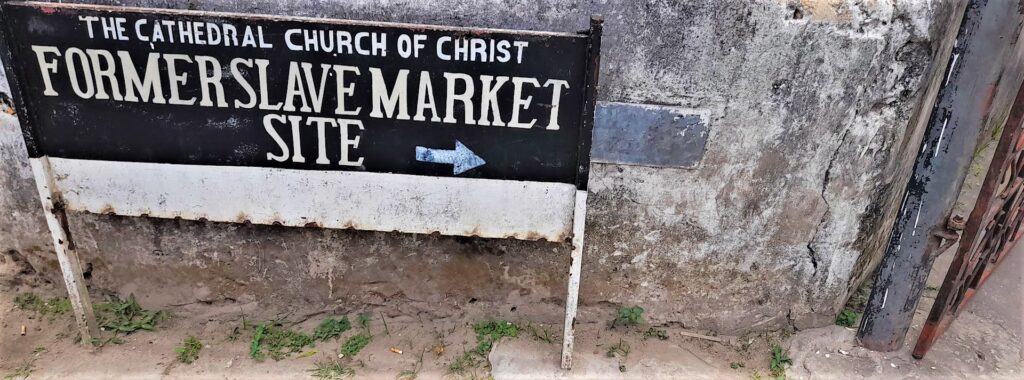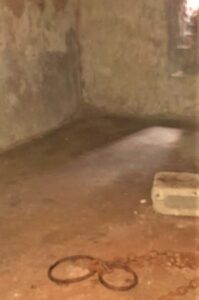» posted on Monday, September 26th, 2022 by Linda Lou Burton
Sultans and Slavers
Linda Lou Burton posting from Zanzibar Serena Hotel, Stone Town, Zanzibar, Tanzania – “A fabled land of spices and a vile center of slavery.” That was Zanzibar’s world-wide reputation back in the 19th century. It was, in fact, the main slave-trading port of the African Great Lakes region; as many as 50,000 slaves were passed through the slave markets of Zanzibar each year. David Livingstone, a British missionary and explorer, estimated that 80,000 new slaves died each year before ever reaching the island. Tippu Tip was the most notorious slaver, under several sultans, and also a trader, plantation owner, and governor. 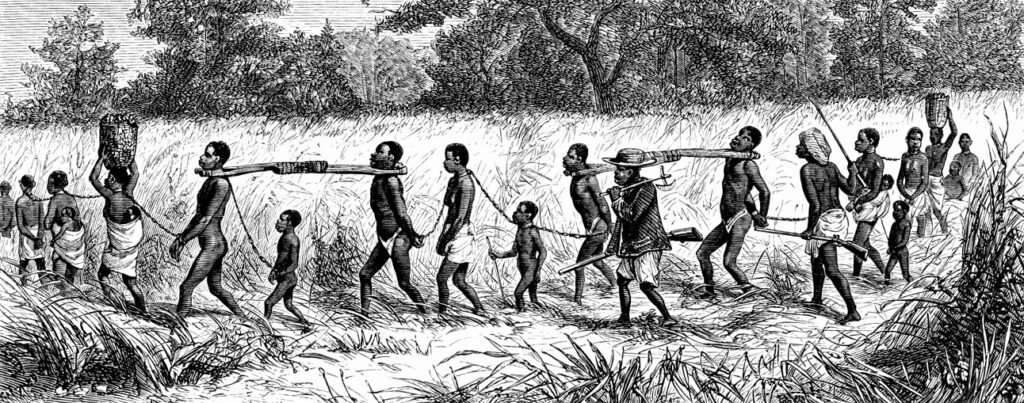 The United Kingdom’s early interest in Zanzibar was motivated both by commerce (all those spices) and by the determination to end the slave trade. In 1822, the British signed the first of a series of treaties with Zanzibar Sultans to curb this trade; the slave trade was officially abolished in 1876 during the rule of Sultan Barghash although slavery itself remained legal in Zanzibar until 1897. Take a look at two main players on the Zanzibari stage.
The United Kingdom’s early interest in Zanzibar was motivated both by commerce (all those spices) and by the determination to end the slave trade. In 1822, the British signed the first of a series of treaties with Zanzibar Sultans to curb this trade; the slave trade was officially abolished in 1876 during the rule of Sultan Barghash although slavery itself remained legal in Zanzibar until 1897. Take a look at two main players on the Zanzibari stage.
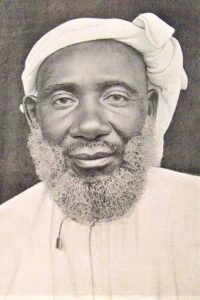 Tippu. Tippu Tip (1832-1905) was an Afro-Omani ivory and slave trader who was born and died in Zanzibar. His real name is longer than I have space for so I’ll use his nickname, which kind of sticks in your head anyway. Tippu Tib, as he was first known, translates to “gatherer together of wealth;” the “Tib” changed to “Tip” because of the “tiptip” sound his guns made during his expeditions. At least, that’s his claim; he wrote a book about himself which was published in Britain in 1907. Either nickname fits; Tippu became a wealthy man trading in slaves for Zanzibar’s clove plantations. He led many expeditions into Central Africa, establishing profitable trading posts deep into the Congo Basin. Between 1884 and 1887 he claimed the Eastern Congo for himself and for the Sultan of Zanzibar, Barghash bin Said el Busaidi. By 1895, he had acquired seven plantations and 10,000 slaves. He became the most well-known slave trader in Africa, supplying much of the world with black slaves.
Tippu. Tippu Tip (1832-1905) was an Afro-Omani ivory and slave trader who was born and died in Zanzibar. His real name is longer than I have space for so I’ll use his nickname, which kind of sticks in your head anyway. Tippu Tib, as he was first known, translates to “gatherer together of wealth;” the “Tib” changed to “Tip” because of the “tiptip” sound his guns made during his expeditions. At least, that’s his claim; he wrote a book about himself which was published in Britain in 1907. Either nickname fits; Tippu became a wealthy man trading in slaves for Zanzibar’s clove plantations. He led many expeditions into Central Africa, establishing profitable trading posts deep into the Congo Basin. Between 1884 and 1887 he claimed the Eastern Congo for himself and for the Sultan of Zanzibar, Barghash bin Said el Busaidi. By 1895, he had acquired seven plantations and 10,000 slaves. He became the most well-known slave trader in Africa, supplying much of the world with black slaves.
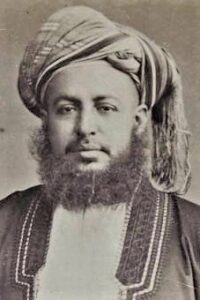 Barghash. Barghash bin Said al-Busaidi (1836-1888) was an Omani Sultan and the second Sultan of Zanzibar, ruling from October 7, 1870 to March 26, 1888. Described as having a sharp and charming character, he is credited with building much of the infrastructure of Stone Town, including piped water, public baths, a police force, roads, parks, hospital, and large administrative buildings such as the House of Wonders. Barghash had a treaty with the British to help stop the slave trade in Zanzibar, but did not always keep his commitment. In June 1873 John Kirk, acting British Consul, received contradictory instructions from London; one to issue an ultimatum to the Sultan that the slave trade must be stopped and the slave market closed, under threat of blockade; the other not to enforce a blockade which might be taken as an act of war. Kirk showed only the first instruction to Barghash, who capitulated, signing a further treaty with Britain prohibiting slave trade in his kingdom, and immediately closing the slave market.
Barghash. Barghash bin Said al-Busaidi (1836-1888) was an Omani Sultan and the second Sultan of Zanzibar, ruling from October 7, 1870 to March 26, 1888. Described as having a sharp and charming character, he is credited with building much of the infrastructure of Stone Town, including piped water, public baths, a police force, roads, parks, hospital, and large administrative buildings such as the House of Wonders. Barghash had a treaty with the British to help stop the slave trade in Zanzibar, but did not always keep his commitment. In June 1873 John Kirk, acting British Consul, received contradictory instructions from London; one to issue an ultimatum to the Sultan that the slave trade must be stopped and the slave market closed, under threat of blockade; the other not to enforce a blockade which might be taken as an act of war. Kirk showed only the first instruction to Barghash, who capitulated, signing a further treaty with Britain prohibiting slave trade in his kingdom, and immediately closing the slave market.
There are 1,709 buildings in Stone Town, a UNESCO World Heritage Site. Major buildings include Christ Church Anglican Cathedral commemorating the work of David Livingstone in abolishing the slave trade and built on the site of the last slave market; the residence of slave trader Tippu Tip; and the House of Wonders, the large ceremonial palace built by Sultan Barghash; all included in Rick’s Walking Tour this morning. I’ll start with the church. 
The church is located in Mkunazini Road, in the center of the old town, and occupies a large area where the biggest slave market of Zanzibar used to be; its construction was to celebrate the end of slavery. The altar is said to be in the exact place where the main “whipping post” of the market was. In the square there is a monument to the slaves showing human figures in chains emerging from a pit.
The last two buildings are the former home of Tippu Tip, and the House of Wonders. Although Stone Town was included in UNESCO’s World Sites in 2000, this designation does not provide complete protection for the town’s heritage. About 80% of the 1,709 buildings are in a deteriorating condition. Some major restoration projects, especially on the seafront, have been done in recent times by the Aga Khan Trust for Culture.
Zanzibar Serena Hotel https://www.serenahotels.com/zanzibar
Fisherman’s Tours https://fishermantours.com/
Next Post: Food, Facts & A Fort


